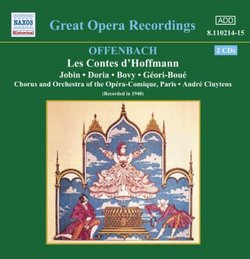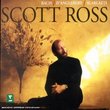| All Artists: Jacques Offenbach, André Cluytens, Andre Pernet, Andre Vessieres, André Philippe, Charles Cambon, Charles Soix, Fanely Revoil, Louis Musy, Raoul Jobin, Raymond Amade, Rene Lapelletrie, Renee Doria, Roger Bourdin, Vina Bovy Title: Offenbach: Les Contes d'Hoffmann Members Wishing: 0 Total Copies: 0 Label: Naxos Original Release Date: 1/1/1948 Re-Release Date: 10/22/2002 Genre: Classical Style: Opera & Classical Vocal Number of Discs: 2 SwapaCD Credits: 2 UPC: 636943121429 |
Search - Jacques Offenbach, André Cluytens, Andre Pernet :: Offenbach: Les Contes d'Hoffmann
 | Jacques Offenbach, André Cluytens, Andre Pernet Offenbach: Les Contes d'Hoffmann Genre: Classical |
Larger Image |
CD DetailsSimilar CDs
|
CD ReviewsA "Hoffmann" from Paris, 1948. John Austin | Kangaroo Ground, Australia | 02/22/2003 (4 out of 5 stars) "Ward Marston, for the Naxos label, continues his work of remastering and reissuing opera recordings dating from the days of 78s. This one dates from the late 1940s. It has had many reissues, and the "Gramophone" still lists it as the recommended recording of "Les Contes d'Hoffmann". It boasts a totally French cast and production. Artistic director Michel de Bry (uncredited in this Naxos reissue) made the wise decision to include two singers whose careers were never in opera: Fanèly Revoil (operetta) and Bourvil (film). Their work here is some of the most enjoyable in the whole production. In terms of singers, it is a large cast. Nineteen soloists take the various parts, the tradition of singers doubling parts being retained only in the allocation of four servant roles to Bourvil. Those who know this opera and its history well will be aware that one soprano should represent all the women with whom Hoffman falls in love, and one baritone all the evil characters who frustrate him. Here, however, you will find an agile Olympia (Renée Doria), an accomplished Giulietta (Vina Bovy) and a piercing Antonia (Géori-Boué) and a trio of individual baritones. Raoul Jobin is an acceptable Hoffmann, lacking only a degree of tenderness in some moments of Offenbach's wonderful score. Belgian born but French trained conductor Andre Cluytens directs, preferring fast speeds to finesse and delicate phrasing. If you think the dictates of four minute 78 sides caused this, you'd be wrong. His approach is little different in an EMI recording he directed for LP release ten years later. The recording was made in the Théâtre des Champs-Elysées. If the acoustic quality is rather dry, it nevertheless is flattering to the orchestra's violin section." 1948 Hoffmann Achieves Adequacy L. E. Cantrell | Vancouver, British Columbia Canada | 03/03/2003 (3 out of 5 stars) "Offenbach died prior to the completion of this, his one seriously-intended opera. As a consequence, it has no universally accepted form. Musical historians are of the opinion that Offenbach intended the Opera Comique format of songs punctuated by long patches of spoken dialogue. Les Contes d'Hoffmann is based on a long-forgotten play that was structured in such a way that the intended order of the opera is deduced to have been prologue--dancing doll (Olympia)--dying soprano (Antonia)--Venice (Giulietta)--epilogue. In the course of cobbling together a playable piece out of Offenbach's sketches, 19th and early 20th Century impresarios hired lesser musicians to set spoken words to music, sometimes to themes by Offenbach but as often as not out of thin air. Scholars have decided that some music, most notably the Diamant aria in the Venice sequence has been imported without authority from other Offenchiana. As for the Barcarolle, whether for two, four, six or eight voices--heaven only knows how or where it should be placed.
From some reason, contemporary conductors have become oddly subservient to scholarship rather than musicianship. The fine aria, "Scintille, diamant", has been cast forth from some recordings. In many contemporary performances, Act III is set in Venice, despite the fact that the dying soprano sequence provides a far-stronger musical ending to the three tales. The role of Hoffmann's gender-questionable companion/muse, Niklausse, has been assigned to both mezzos and baritones. Then there is (are) the villain(s) Does Hoffmann have one enemy or four? And his woman (women)? Again, one or four? Of contemporary recordings, the Domingo-Sutherland-Bonynge recording should have been a classic. It uses one villain and one beloved, but it is disfigured by dreary deserts of overdone and often overheated dialogue, some of which continues onto musical passages and wrecks them. (Just try listening to it after the first hearing without grinding your teeth!) This performance dates from a time prior to the onset of scholarly piffle. It offers a format settled upon in the first decade of the 20th Century. It includes "Scintille, diamant", sung recitatives, an acceptable location and suitable voices for the Barcarolle. Heck, it even gives you a second chance to hear it. Hoffmann visits Venice in Act II as he should. Niklausse, wearing pants or not, is a woman. Poor Hoffmann is bedeviled by four villains and his lady love is also subdivided. This version is not in the least authentic textually but it is dramatically and musically effective. It is probably very close to what Offenbach, the very definition of a practical theater man, would have turned out had he lived to see a few performances of his last and greatest work. The learned and widely-ranging John Austin of Kangaroo Ground, Australia, has awarded this recording four stars. It is only with the greatest reluctance that I depart from his excellent guidance. As Mr. Austin points out, the cast is entirely French. Numbering no less than 19 soloists, it must represent a large fraction of the performing company of the Opera Comique of 1948. Their performance is as authentically French as can be--right as rain--spot on, no question about that. The only problem is that the performers of the lesser roles are basically terrible. Among the major singers, probably best known on this side of the Atlantic is the Hoffmann, Raoul Jobin. His performance here strives for adequacy and triumphantly achieves it. Seventeen others occupy the artistic range from very good to minimally adequate to awful. Mr. Austin, whose knowledge of such things holds me in awe, informs us that the individual doing all the servant parts came from the film industry. On hearing him, alas, one can only wish that he had stayed there. Mr. Austin refers to the sound on these CDs as rather dry. I prefer to describe it as thin and arid. For those seeking Les Contes d'Hoffmann at a bargain price or for anyone seeking an exciting traditional performance, I recommend Opera d'Oro's live performance led by the great Sandor Konya and ably seconded by the expertly menacing Gabriel Becquier as Hoffmann's multi-named nemesis. I give this Naxos set four stars for its traditional form and its impeccable French performance authenticity and deduct one for inadequate sound--three stars." |





